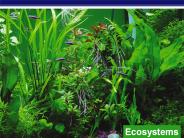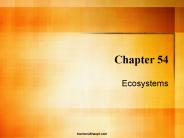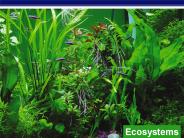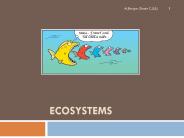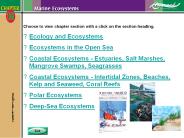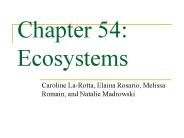Ecosysteme PowerPoint PPT Presentations
All Time
Recommended
Definition of Ecosystem ... no inherent definition. of spatial dimension. Gallatin ... Forest provide wood, food, habitat, fuel, pharmaceuticals, recreation ...
| PowerPoint PPT presentation | free to view
Sci.7.12B, Sci.7.8B and Sci.7.12D What is an Ecosystem? An ecosystem is composed of all the living and nonliving things that interact in a particular area.
| PowerPoint PPT presentation | free to view
information about the ecosystems
| PowerPoint PPT presentation | free to download
PowerPoint Presentation ... Ecosystems
| PowerPoint PPT presentation | free to download
Ecosystems What do you know about ecosystems?
| PowerPoint PPT presentation | free to download
Chapter 54 Ecosystems Ecosystems Ecosystems are all of the organisms living in a community along with the abiotic factors with which they interact.
| PowerPoint PPT presentation | free to download
PowerPoint Presentation ... Ecosystems
| PowerPoint PPT presentation | free to download
Ecosystems Georgia Performance Standards S4L1: Students will describe the roles of organisms and the flow of energy within an ecosystem. Identify roles of producers ...
| PowerPoint PPT presentation | free to download
Ecosystems Aim- What are ecosystems and how do they work?
| PowerPoint PPT presentation | free to view
ECOSYSTEMS WHAT IS ECOLOGY? Ecology is the study of relationships between living things and between living things and their environment. WHAT IS AN ECOSYSTEM?
| PowerPoint PPT presentation | free to view
Ecosystems 4th grade Science Ecosystems Ecosystems include both living and nonliving things. Nonliving things include water, rocks, air, light, and soil.
| PowerPoint PPT presentation | free to view
Ecosystems Ecosystems have Living and Nonliving Components Each population in an ecosystem has a range of tolerance to variations in its physical and chemical ...
| PowerPoint PPT presentation | free to view
Chapter 51 Ecosystems Ecosystems Population: all the individuals of a certain species that live in a particular area Community: all the different species that ...
| PowerPoint PPT presentation | free to download
Ecosystems. Groups of living things and the environment they live in make up an ecosystem. Some ecosystems include forests, ponds, and streams. ...
| PowerPoint PPT presentation | free to view
detritus = dead animals and plant tissue, consumed by 1 decomposers (bacteria, ... Large amounts of S leave ecosystem as detritus (washes into streams) ...
| PowerPoint PPT presentation | free to view
Aquatic Ecosystems ... Wetland Bogs Form in depressions left by sheets of ice. ... including southern Florida and Hawaii.
| PowerPoint PPT presentation | free to download
An introduction to ecosystems
| PowerPoint PPT presentation | free to download
CHAPTER 55 ECOSYSTEMS A terrarium, an example of an ecosystem Figure 54.2 Fungi decomposing a log Energy Flow Inorganic Nutrients Table 55-1 Primary Productivity ...
| PowerPoint PPT presentation | free to view
Ecosystems. Photosynthesis. Plants take in energy from the sun. ... In most ecosystems, plants of the main population are where organisms interact. ...
| PowerPoint PPT presentation | free to view
Ch 3: Ecosystems What Are They and How Do They Work?
| PowerPoint PPT presentation | free to download
Unit 4: Ecosystems 3.1.1 Define Ecosystem Ecosystem = the network of relationships (interactions) among plants, animals (living) and the non-living parts in an ...
| PowerPoint PPT presentation | free to view
Chapter 17 Ecosystems Nitrogen Cycle Living organisms cannot use Nitrogen directly from the atmosphere Nitrogen needed for proteins Plants and bacteria work together ...
| PowerPoint PPT presentation | free to view
WHAT ARE ECOSYSTEMS? Where Things Live Living things need a place to live and grow. Fish live in water. Birds live in trees and fly through the air.
| PowerPoint PPT presentation | free to download
Grade 7 Science Unit 1 Interactions Within Ecosystems Chapter 1 Intensity of sunlight Plants need light to survive Intensity of sunlight Plants need light to survive ...
| PowerPoint PPT presentation | free to view
Ecosystems and Biomes Chapter 2: Section 1 Energy Flow in Ecosystems
| PowerPoint PPT presentation | free to view
Interactions Within Ecosystems http://www.kidsgeo.com/images/ecosystem.jpg
| PowerPoint PPT presentation | free to download
Aquatic Ecosystems Chapter 7 Flowing water zones- (Planet Earth) Source: Tend to be narrow, swift, clear, cold, nutrient poor, and highly oxygenated; not very ...
| PowerPoint PPT presentation | free to download
CHANGES IN ECOSYSTEMS Predict the effects of changes in ecosystems caused by living things. Predict what might happen in this taiga ecosystem if an acid rainfall ...
| PowerPoint PPT presentation | free to download
Parts of Ecosystems What are nonliving parts of ecosystems? What are nonliving parts of ecosystems? An ecosystem is made up of all the living and nonliving things ...
| PowerPoint PPT presentation | free to view
Ecology and Ecosystems Ecosystems in the Open Sea Coastal Ecosystems - Estuaries, Salt Marshes, Mangrove Swamps, Seagrasses Coastal Ecosystems - Intertidal Zones ...
| PowerPoint PPT presentation | free to download
Ecosystems and Communities Chapter 4 The Role of Climate - Sec. 4.1 Organisms vary in their adaptations to temperature, rainfall, and other environmental conditions.
| PowerPoint PPT presentation | free to download
Topic #2 Ecosystems at Risk Definition Ecosystem: the dynamic complex of plant, animal and micro-organism communities and their non-living environment as a ...
| PowerPoint PPT presentation | free to view
Ecology and Ecosystems Ecosystems in the Open Sea Coastal Ecosystems - Estuaries, Salt Marshes, Mangrove Swamps, Seagrasses Coastal Ecosystems - Intertidal Zones ...
| PowerPoint PPT presentation | free to download
Ecosystems Table of Contents 1. Process Skills 2. Cells 3. Classifying Animals 4. ECOSYSTEMS----- Make this the next clean page in your journal Ecosystem ...
| PowerPoint PPT presentation | free to view
Chapter 22 Ecosystems and the Biosphere
| PowerPoint PPT presentation | free to download
Relationships in Ecosystems Chapter 1 Lesson 2 GLE 0507.2.1: Investigate different nutritional relationships among organisms in an ecosystem. GLE 0507.2.2: Explain ...
| PowerPoint PPT presentation | free to download
Chapter 55 Ecosystems and Restoration Ecology
| PowerPoint PPT presentation | free to download
Ecosystems Reading: Freeman Chapter 54 An ecosystem is the unit composed of all the living things in a single place at a given time, in addition to, the important non ...
| PowerPoint PPT presentation | free to view
Understanding Ecology and Ecosystems Population Growth Determined by immigration, emigration, natality, and mortality. Immigration is the act of an organism moving ...
| PowerPoint PPT presentation | free to view
Chapter 55 Dynamics of Ecosystems
| PowerPoint PPT presentation | free to download
Ch 4 Ecosystems videos The phosphorus cycle is the movement of phosphorus in different chemical forms from the surroundings to organisms and then back to the ...
| PowerPoint PPT presentation | free to download
Introducing Ecosystems Introducing Ecosystems Ecosystem: all the living organisms in an area and their non-living environment Introducing Ecosystems Ecosystem: all ...
| PowerPoint PPT presentation | free to view
Chapter 55 Ecosystems and Restoration Ecology
| PowerPoint PPT presentation | free to download
Ecosystems: Everything Is Connected In nature, things that we would never think were connected can be linked to each other ? Everything is Interconnected
| PowerPoint PPT presentation | free to view
Energy Flow in Ecosystems Cycles of Matter Biogeography Biomes Aquatic Ecosystems Food Chains and Food Webs The movement of energy though an ecosystem can be shown in ...
| PowerPoint PPT presentation | free to download
What causes ecosystems to change? Changes caused by humans: Water pollution. Air ... How can humans help to prevent changes in ecosystems? Use resources wisely ...
| PowerPoint PPT presentation | free to view
Chapter 3 Ecosystems and Energy
| PowerPoint PPT presentation | free to download
Human use of ecosystems: Humans have decreased biodiversity of ecosystems at a very fast rate 5 factors affecting biodiversity: 1. Habitat change Humans alter a ...
| PowerPoint PPT presentation | free to view
Introduction to ecosystems. Examining the roles of animals in an ecosystem (producers, consumers, etc.). Details types and adaptations of these animals to fit roles. Introduction to food chains.
| PowerPoint PPT presentation | free to download
The Living World: Ecosystems (Chapter 10) Bioconcentration a phenomenon by which the concentration of a contaminant in the tissues of living organisms tends to ...
| PowerPoint PPT presentation | free to view
Presented by: Ms. Hill Environment Education Officer An ecosystem is a community of plants, animals and smaller organisms that live, feed, reproduce and interact in ...
| PowerPoint PPT presentation | free to view
Ecosystems are always changing. Populations change over time. Limiting factors: any factor or condition that limits the growth of a population in an ecosystem ...
| PowerPoint PPT presentation | free to view
Chapter 4 Ecosystems & Energy Ecology The branch of biology that deals with the interactions between organisms and the relationship between organisms and the environment.
| PowerPoint PPT presentation | free to view
Chapter 54: Ecosystems Caroline La-Rotta, Elaina Rosario, Melissa Romain, and Natalie Madrowski
| PowerPoint PPT presentation | free to download
An ecosystem can be defined in a much simpler manner by drawing a circle around organizations, individuals, and things that share or complement a set of interests.
| PowerPoint PPT presentation | free to download




